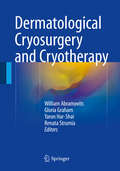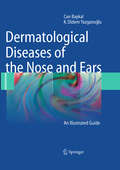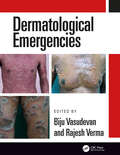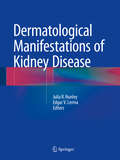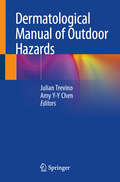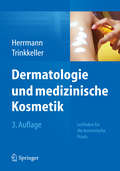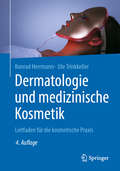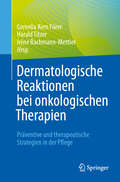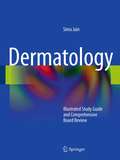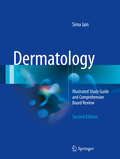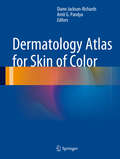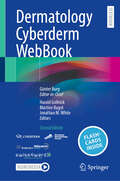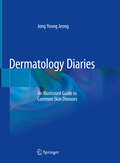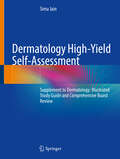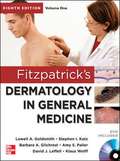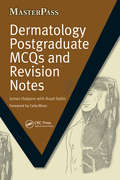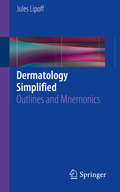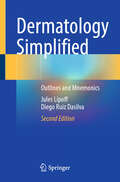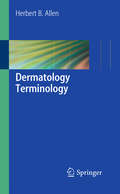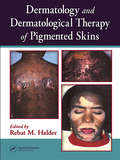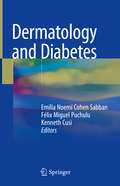- Table View
- List View
Dermatological Cryosurgery and Cryotherapy
by Renata Strumia William Abramovits Gloria Graham Yaron Har-ShaiHighlighting the available evidence base, this books is the most authoritative manual for clinicians based upon the risks and benefits of the procedure across all indications with special emphasis on a comprehensive review of the many skin lesions amenable to treatment with cryosurgeryPractical and yet comprehensive in outlook, in this a group of international authorities in all aspects of cryosurgery and cryotherapy present the most comprehensive clinically relevant reference for practicing dermatology physicians.
Dermatological Diseases of the Nose and Ears
by K. Didem Yazganoglu Can Baykal"Dermatological Diseases of the Nose and Ears" gives comprehensive information about the lesions of these regions. It contains high quality original clinical pictures, which make the diagnosis easier in this important aspect of clinical dermatological practice. All diseases involving the nose and ears are discussed separately with a clinical differential diagnostic approach. As a result approximately 600 different diseases are addressed in the book. In clinical practice, physicians may observe lesions of the nose or ear only. After identifying the elementary lesion, the clinician can more easily uncover the diagnosis of a local or disseminated or systemic disease with the help of this book. Furthermore, this color illustrated book guides the reader to the diagnosis of the prevalent skin tumors frequently involving these localizations, addressing an important health care problem.
Dermatological Emergencies
by Rajesh Verma Biju Vasudevan‘Dermatological Emergencies’ aims to cover aspects of situations and their management when they present in a Dermatology setup. This includes severe drug reactions, bullous disorders, erythroderma, infections, vasculitis and systemic emergencies presenting with skin signs. This book guides the reader to recognize such emergencies, helps to approach the initial phase of management, identifies the investigations, thus leading to a holistic management of the scene. Case scenarios are used in all chapters with logical flow of text, flowcharts, algorithms and representative clinical and laboratory images for better understanding of the readers. Key Features Details all dermatological emergencies Discusses manifestation of these emergencies with unique algorithms and flowcharts Examines case scenarios for first-hand experience Consists of Do's and Don'ts for effective management of cases Uses high quality clinical images for clarity
Dermatological Manifestations of Kidney Disease
by Edgar V. Lerma Julia R. NunleyNearly all patients with chronic kidney disease (CKD) have at least one significant dermatologic manifestation. This all-inclusive reference covers the wide array of cutaneous manifestations attributable to CKD, kidney transplantation and the pharmacological aspects of the disease process. Each chapter provides pathobiology, extensive clinical discussions, full-color images and in-depth treatment options. Dermatological Manifestations of Kidney Disease helps the practitioner, nephrologist, resident and student recognize, appropriately evaluate and treat these conditions more effectively.
Dermatological Manual of Outdoor Hazards
by Julian Trevino Amy Y-Y ChenThis book comprehensively covers the knowledge and skills that physicians, medical students and mid-level providers (physician assistants and nurse practitioners) need in order to care for patients with plant or arthropod exposures. It presents the epidemiology, pathogenesis and clinical manifestations of selected exposures, before discussing prevention strategies and management options for adverse cutaneous reactions and selected systemic manifestations. Lastly, it reviews emerging viruses carried by arthropods and related human diseases, such as the Zika virus. Dermatological Manual of Outdoor Hazards covers a broad range of arthropod and plant exposures, with a specific focus on dermatological manifestations, making it a valuable resource for all trainees and practicing dermatologists, primary care physicians and emergency physicians who treat these patients.
Dermatological and Transdermal Formulations
by Kenneth A. WaltersContaining 350 illustrations, tables, and equations and covering AAPS/FDA guidelines for the experimentation and analysis of in vivo and in vitro percutaneous absorption, this reference provides comprehensive coverage of the development, preparation, and application of topical and transdermal therapeutic systems. Recognized international experts di
Dermatologie Venerologie: Grundlagen. Klinik. Atlas (Springer-Lehrbuch)
by Thomas Schwarz Peter FritschDieses Buch ist grundlegende wissenschaftliche Einführung und reichhaltiges Nachschlagewerk in der Dermatologie. Sein Bestreben ist, das Warum und Wieso tischfertig aufzubereiten und gleichzeitig Lesevergnügen zu gewähren. Für die Praxis bietet es eine verlässliche Orientierung in Diagnostik und Therapie, und durch die konzentrierte, aber wohldosierte Darstellung ist es gleichermaßen zur Prüfungsvorbereitung geeignet.Die vollständig überarbeitete 3. Auflage zeigt die Dermatologie und Venerologie in all ihren Facetten. Das Buch beschreibt alle wichtigen dermatologischen Krankheiten und gibt einen Einblick in angrenzende Fachgebiete wie Phlebologie. Das erfolgreiche didaktische Konzept stützt sich auf viele Fallbeispiele, erklärende Nebenbemerkungen sowie zahlreiche brillante Bilder. Das Buch ist ein einzigartiger Dermatologie-Kompass für alle praktisch tätigen neugierigen Ärzte, Dermatologen in oder nach der Weiterbildung und Medizinstudenten.
Dermatologie der Katze
by Chiara Noli Silvia ColomboDieses reich illustrierte Handbuch deckt alle Aspekte der modernen Katzendermatologie ab, von der Herangehensweise an verschiedene Anzeichen und Symptome bis hin zur Beschreibung der Ätiologie, Pathogenese, klinischen Manifestation, Diagnose und aktuellen Behandlung jeder dermatologischen Erkrankung der Katze. Daher dient dieses Handbuch als unverzichtbarer praktischer Leitfaden für den vielbeschäftigten Praktiker, um Katzen mit dermatologischen Erkrankungen schnell und sicher zu behandeln, und bietet ein aktuelles und vollständiges Nachschlagewerk für den Katzentierarzt und den Veterinärdermatologen.
Dermatologie und medizinische Kosmetik
by Konrad Herrmann Ute TrinkkellerDieses Buch beantwortet der Kosmetikerin während der Examensvorbereitung und im Berufsalltag alle Fragen zur Dermatologie. Aufbau und Physiologie der Haut werden in einfachen und präzisen Worten dargestellt. Alle wichtigen Hauterkrankungen, zum Beispiel Nagelerkrankungen, Mykosen, Ekzeme, Schweißdrüsenerkrankungen, Tumoren und viele weitere, werden inklusive der Therapieoptionen erläutert. Zahlreiche Schemazeichnungen und Fotos von Fallbeispielen helfen, die Sachverhalte besser zu verstehen und schulen den ,,dermatologischen Blick". Besonders wertvoll für die praktische Arbeit sind die Kapitel über medizinisch-kosmetische Behandlungsmethoden und bewährte Rezepturen. Bieten Sie Ihren Kunden eine sichere und kompetente Beratung und Behandlung! Lernen Sie, wie Sie Hauterkrankungen erkennen, wie diese behandelt und vermieden werden und wann Sie Ihren Kunden die Rücksprache mit einem Dermatologen empfehlen sollten. Das bewährte Autorenteam, bestehend aus einer Fachlehrerin für Körperpflege und einem Dermatologen, hat für die dritte Auflage das gesamte Buch überarbeitet und auf den aktuellsten Stand gebracht.
Dermatologie und medizinische Kosmetik: Leitfaden für die kosmetische Praxis
by Konrad Herrmann Ute TrinkkellerDieses Buch beantwortet bei der Examensvorbereitung und im späteren Berufsalltag alle Fragen zur Dermatologie umfassend und kompetent. Aufbau und Physiologie der Haut werden in einfachen und präzisen Worten dargestellt. Alle wichtigen Hauterkrankungen, zum Beispiel Nagelerkrankungen, Mykosen, Ekzeme, Schweißdrüsenerkrankungen, Tumoren und viele weitere, werden inklusive der Therapieoptionen erläutert. Zahlreiche Schemazeichnungen und Fotos von Fallbeispielen helfen, die Sachverhalte besser zu verstehen und schulen den „dermatologischen Blick“. Besonders wertvoll für die praktische Arbeit sind die Kapitel über moderne und praktikable medizinisch-kosmetische Behandlungsmethoden und bewährte Rezepturen. Besonderen Wert wird in diesem Zusammenhang auch auf rechtliche Fragen gelegt. Bieten Sie Ihren Kunden eine sichere und kompetente Beratung und Behandlung! Lernen Sie, wie Sie Hauterkrankungen erkennen, wie diese behandelt und vermieden werden und wann Sie Ihren Kunden die Rücksprache mit einem Dermatologen empfehlen sollten. Das bewährte Autorenteam, bestehend aus einer Fachlehrerin für Körperpflege und klinischer Kosmetik und einem Dermatologen hat für die vierte Auflage das gesamte Buch überarbeitet und auf den aktuellen Stand gebracht.
Dermatologische Reaktionen bei onkologischen Therapien: Präventive und therapeutische Strategien in der Pflege
by Irène Bachmann-Mettler Cornelia Kern Fürer Harald TitzerMenschen mit Hautveränderungen kompetent und interprofessionell pflegen und behandeln!Dieses Buch richtet sich an Pflegefachpersonen, die in ihrem klinischen Praxisfeld Menschen mit einer Krebserkrankung betreuen, beraten und begleiten. Es bietet umfassendes Fachwissen und konkrete Handlungsempfehlungen für eine kompetente Versorgung von dermatologischen Reaktionen. Denn Veränderungen an Haut, Schleimhaut, Haaren und Nägeln treten unter antineoplastischer Behandlung, sowie unter Radiotherapie in sehr unterschiedlichen Variationen auf. Sie sind bedeutsam, da sie medizinische und psychosoziale Folgen haben. Werden sie nicht adäquat behandelt, haben sie einen negativen Einfluss auf die Therapieakzeptanz und die Lebensqualität der PatientInnen. Die erfahrenen Autorinnen und Autoren zeigen, mit welchen Konzepten und Arzneimitteln Sie die Erkrankten individuell und effektiv unterstützen können.Erweitern Sie Ihre Fachkompetenz im Bereich Onkologie, Radio-Onkologie oder im Wundmanagement!
Dermatology
by Sima JainA fully-illustrated, note-packed volume of information, Dermatology: Illustrated Study Guide and Comprehensive Board Review fulfills a real need for a single study guide for the Dermatology Board Exam. Written by a previous Chief Resident of Dermatology at the University of Illinois at Chicago Medical Center, the text focuses on presenting comprehensive information in an easy-to-understand, easy-to-remember format. Tips, tricks, short lists, and tables fill every inch of this book--a must-have for any dermatology resident. Features: Acts as a concise go-to review book for the Dermatology Board Exam Hundreds of author notes pinpointing important information Information presented in an easy-to-read format Scores of mnemonics and memory tricks to mentally organize information Over 500 high-quality images placed parallel to the represented skin disorder Life after Boards--essential tips on coding and documentation
Dermatology
by Sima JainA fully-illustrated, note-packed volume of information, Dermatology: Illustrated Study Guide and Comprehensive Board Review fulfills a real need for a single study guide for the Dermatology Board Exam. Written by a previous Chief Resident of Dermatology at the University of Illinois at Chicago Medical Center, the text focuses on presenting comprehensive information in an easy-to-understand, easy-to-remember format. The second edition of this incredibly popular book includes updated coverage of new medications, new entities, and over 300 additional full-color clinical and histological images. Following the layout of the successful first edition, even more tips, short lists, and tables, including mnemonics and memory tricks to mentally organize information fill every inch of this book - a must-have for any dermatologist and dermatology resident.
Dermatology Atlas for Skin of Color
by Diane Jackson-Richards Amit G. PandyaThis atlas, containing more than 300 color photos, focuses on those dermatologic conditions that are most common in ethnic skin or skin of color. It includes succinct explanations of each disease process, describes clinical findings and presents key information on diagnosis and treatment. Individual chapters are devoted to pigmentary disorders, follicular disorders, hair and scalp disorders, eczemas, papulosquamous disorders, granulomatous disorders, connective tissue diseases, infectious diseases, scarring disorders, cutaneous neoplasms, photodermatoses and drug eruptions. The fact that this atlas covers skin disorders that affect patients of all ethnic backgrounds ensures that it will be of worldwide relevance. It will serve as a valuable reference for dermatologists and a range of other health care providers.
Dermatology Cyberderm WebBook
by Günter BurgDermato-Venereology is an obligatory inbuilt discipline in medical undergraduate curricula worldwide, and 20-25% of patients in the office of a general practitioner relate to dermatologic problems. Nevertheless, only 2% of medical students will specialize in dermatology: it is thus of primary importance to give medical students a solid training in dermatology during medical undergraduate studies. The Dermatology Cyberderm WebBook will be a valued pillar of knowledge before and after the examination (postgraduate) once established in their medical profession. This handy paperback work presents contents in an easy-to read, brief and didactic style, with all typical clinical pictures, and complemented with flashcards for memorizing. Topics follow the official international catalogues of learning objectives, and the ICD-11 (International Classification of Diseases 11th Revision), fundamental orientation tool for the undergraduate student as well as for the postgraduate physician in his/her daily practice. Each chapter shows the Level/Grading of importance (A, B, and C) of the topic, to help students planning what is needed for their exams. Level A: "Know and care" corresponds to common diseases that the General Practitioner (GP) must be able to diagnose and to treat. Level B: "Know and care with guidance" corresponds to diseases which should be referred to the dermatologist, but still within the capacity of the GP to evaluate the emergency and to make the first intervention/management step. The GP must be guided to follow the patient in cooperation with the Dermato-Venereologist. Level C: "Know and refer" corresponds to diseases which the GP must know just enough to recognize and understand and to refer to the Dermato-Venereologist. The Dermatology Cyberderm WebBook delivers all complete important information in a compact and concise style. The book is handy, richly illustrated for easy consultation, and will be the choice go-to resource for undergraduate students, as well as for postgraduate physicians in their daily routine work.
Dermatology Diaries: An Illustrated Guide to Common Skin Diseases
by Jong Yeong JeongIn this book, the author presents a collection of 100 skin diseases and shares an invaluable record of his diagnoses and treatment strategies. This book will serve as a comprehensive and practical companion, expertly guiding readers through the identification of a diverse spectrum of common dermatological conditions typically encountered within dermatology clinics. A beauty of this book is the abundant clinical photography accompanying each case, providing visual context that enhances the reader's understanding of the presented skin diseases. For those who are seeking a guide for clinical practice, training, or a deeper understanding of dermatology, this book will be an efficient and practical reference. The translation was done with the help of artificial intelligence. A subsequent human revision was done primarily in terms of content. This book is a translation of an original Korean edition. The translation was done with the help of artificial intelligence (machine translation by the service DeepL.com). A subsequent human revision was done primarily in terms of content, so that the book will read stylistically differently from a conventional translation
Dermatology High-Yield Self-Assessment: Supplement to Dermatology: Illustrated Study Guide and Comprehensive Board Review
by Sima JainThe Dermatology Board Exam consists of 200 multiple-choice items and is administered over a four-hour session. In the United States, there are an estimated 9,600 dermatologists and 7,800 dermatology practices. In 2021, there were 541 new dermatologists certified by the American Board of Dermatologists. This Q&A book is the perfect companion book to Dermatology: Illustrated Study Guide and Comprehensive Board Review and allows readers to gauge their knowledge prior to taking the Dermatology Board. This self-assessment Q&A book contains over 400 multiple-choice questions that addresses topics covered on the exam. It offers over twice the number of questions seen in the Dermatology Board Exam. Each question will discuss core issues in dermatology, including, but not limited to, pediatric cases, infectious diseases, dermatologic surgery, pharmacology, drug reactions, dermatopathology and dermoscopy. Questions will also cover basic science and immunology, offering a comprehensive review for dermatologists taking the board exam or recertifying. This book is the perfect companion to Dermatology: Illustrated Study Guide and Comprehensive Board Review and allows readers to self-assess prior to their board exams.
Dermatology In General Medicine (Eighth Edition)
by David J. Leffell Lowell A. Goldsmith Stephen I. Katz Barbara A. Gilchrest Amy Paller Klaus WolffThe landmark dermatology text that bridges the gap between science and clinical medicine—updated for today’s practice <P><P> Generations of clinicians, skin biologists, residents, and educators have acclaimed Fitzpatrick’s as the most authoritative and complete guide to dermatologic basic sciences, histopathology, diagnosis, and treatment. Edition after edition, it reflects the latest insights into skin diseases and skin biology—and their practical relevance to general internal medicine—while covering the scientific foundations of the specialty. <P><P> This classic yet cutting-edge text is supported by the expert insights of more than 500 internationally respected contributors, and it covers everything dermatologists need to know about skin, dermatologic signs of underlying disease, and the management of all skin diseases, including acne, skin cancer, and psoriasis.
Dermatology Postgraduate MCQs and Revision Notes (MasterPass)
by James HalpernPostgraduates studying dermatology can face a lack of appropriate revision aids: reference books are often too exhaustive or out-of-date, while undergraduate and introductory texts lack the necessary detail and depth. This book is specifically designed for postgraduate examinations, and is the perfect accompaniment for the diploma in dermatology.
Dermatology Simplified
by Jules LipoffThis book is derived from notes taken during a dermatology residency and it represents a comprehensive yet condensed approach to a dermatology curriculum, listing every entity with only the most important and testable facts and mnemonics. There is an intimidating large amount of material for young dermatologists and other doctors with an interest in dermatology to learn, and this guide puts it all into a concise and manageable context. Further, introductions to the dermatology physical exam and dermatopathology, as well short guides describing the basics of medications, basic science, cosmetics, and surgery are included. The goal of this guide is not primarily to help with visual identification of diagnoses, but rather to help young dermatologists learn to create differential diagnoses and learn all the important facts for myriad diseases. Given its unique approach, this guide will serve new residents well in quickly adapting to a new field, and also, it will serve senior residents as quick review of all topics in preparation for in service and board examinations. In general, there are very few dermatology board review books of any kind and therefore this book will immediately have a market among dermatology students, residents, rotators, and faculty.
Dermatology Simplified: Outlines and Mnemonics
by Jules Lipoff Diego Ruiz DasilvaThis revised and updated practical textbook is derived from notes taken during dermatology residency and represents a comprehensive yet condensed approach to the dermatology curriculum, listing every entity with only the most important and testable facts and mnemonics. There is often an intimidating amount of material for young dermatologists and other doctors with an interest in dermatology to learn, and this guide puts it all into a concise and manageable context. Furthermore, introductions to the dermatology physical exam and dermatopathology, as well as short guides describing the basics of medications, basic science, cosmetics and surgery are included. The goal of Dermatology Simplified is not to help with visual identification of diagnoses, but rather to help young dermatologists learn to create differential diagnoses and memorize all the important facts for myriad diseases. Given its unique approach, this guide will serve new residents well in quickly adapting to their new field, while also helping senior residents as a quick review of all topics in preparation for the in-service and board examinations (reflecting the priorities of the new CORE exams). This book is therefore an important resource for all dermatology students, residents, other trainees on dermatology rotations, and faculty.
Dermatology Terminology
by Herbert B. AllenDermatology terminology is an attempt to describe dermatological diseases with the verbiage dermatologists actually use in speaking to each other. With many disorders, the description can be reduced to a word, or a phrase, or an acronym. This is termed the "keyword" phenomenon, where such a keyword substitutes for a much fuller and much lengthier formal presentation. The keyword, together with a photo of the disease it represents, will be coupled with a short description and a literature reference for that disease. The photos will be from Dr Allens own collection or the collection at Drexel Dermatology.
Dermatology Training: The Essentials
by Mahbub M.U. Chowdhury Tamara W. GriffithsAndrew Y. FinlayDermatology Training: The Essentials helps readers understand what is required to work effectively in a demanding clinical dermatology training programme. Developed by the British Association of Dermatologists and British College of Dermatology, this accessible textbook covers all key themes outlined in the 2021 Joint Royal Colleges of Physicians Training Board (JRCPTB) curriculum. The fundamentals of professional development, clinical practice, general dermatology, therapeutics and procedural dermatology, and specialist areas of dermatology relevant to all UK and international trainees and healthcare professionals are addressed in 29 reader-friendly chapters. Throughout this highly practical textbook, the expert authors provide tips and advice for handling common clinical situations, developing leadership skills, getting into research and gaining surgical experience, as well as key pearls and pitfalls. The book contains over 70 Specialty Certificate Exam (SCE) questions to assist in exam preparation, and includes contributions from current trainees that offer real insights into day-to-day dermatology training. A must-have for all those involved in the dermatology training process, including educational supervisors, this textbook: Provides detailed descriptions of the key themes that trainees in dermatology need to understand Features over 500 clinical images, tables and figures including disease presentations in various skin types, and highlights relevant issues relating to skin diversity Aligns with the new Capabilities in Practice (CiPs) assessment tool, which evaluates the trainee’s ability to deliver and perform in the workplace Dermatology Training: The Essentials is highly recommended reading for all trainees in dermatology, doctors taking the Certificate for Eligibility for Specialist Registration (CESR) route to accreditation in dermatology, general practitioners training for an Extended Role (GPwER), and junior doctors and medical students considering a career in dermatology.
Dermatology and Dermatological Therapy of Pigmented Skins
by Rebat M. HalderApproximately 80 percent of the world's population is pigmented; even in the United States, current projections indicate that by mid-century the majority of the population will be non-Caucasian. US dermatologists are already seeing a significant shift in the makeup of their client population. Yet, despite this changing face of the American populati
Dermatology and Diabetes
by Emilia Noemí Cohen Sabban Félix Miguel Puchulu Kenneth CusiThis book reviews the dermatological manifestations of Diabetes Mellitus, including a broad spectrum of conditions since the dysfunction of the cutaneous barrier, going through cutaneous infections in diabetics, dermatoses associated to Diabetes and manifestations related to Diabetes treatment.Moreover, the book comprises the latest concepts regarding epidemiology, classification, diagnosis and treatment of Diabetes Mellitus, insulin resistance and metabolic syndrome, including useful tools for the management of patients with diabetes. It explains why skin conditions have such a great impact on the quality of life of these patients, particularly the subset of patients with diabetic foot syndrome. Dermatology and Diabetes discusses all these dermatologic conditions and provides a roundup of the current guidelines in diabetic patients. Taking into account the critical differential diagnostic information and therapeutic options, the book is an important reference for clinical dermatologist and all health care professionals involved.
